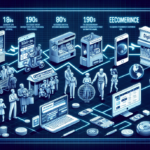Introduction to the Evolution of Ecommerce
Welcome to the dynamic world of ecommerce, where the past decade has seen extraordinary growth and transformative changes in how people shop online. This article delves into the journey of ecommerce, tracing its rise from an emerging trend to a dominant force in the global retail industry. We will explore the key factors contributing to this growth, examine the challenges faced, and look ahead to the exciting future possibilities that await ecommerce.
Technological Advancements Driving Ecommerce Growth
Mobile Commerce: The Smartphone Revolution
The proliferation of smartphones has been a cornerstone in the expansion of ecommerce. As of 2023, there are over 6 billion mobile users worldwide, making mobile devices the primary medium for online shopping. Mobile commerce, or m-commerce, allows consumers to browse, compare, and purchase products seamlessly on the go. According to a Statista report, global mobile commerce sales are projected to reach $3.56 trillion by 2024, underscoring its critical role in ecommerce growth.
Payment Methods: Digital Wallets and Contactless Payments
The evolution of payment methods has significantly enhanced the ecommerce experience. Digital wallets like PayPal, Apple Pay, and Google Wallet offer secure and convenient transaction options, reducing the friction associated with traditional credit and debit card payments. Additionally, the adoption of contactless payment technologies, utilizing Near Field Communication (NFC), has surged, particularly in response to the COVID-19 pandemic, which emphasized the need for touch-free transactions.
Artificial Intelligence and Personalization
Artificial Intelligence (AI) has revolutionized how businesses interact with customers. AI-driven algorithms analyze vast amounts of data to deliver personalized shopping experiences, from product recommendations to tailored marketing messages. According to a Salesforce report, 62% of customers expect companies to adapt based on their actions and behaviors, highlighting the importance of personalization in enhancing customer satisfaction and loyalty.
Key Players and Industry Disruptors
Amazon and Alibaba: Market Dominance
Amazon and Alibaba stand as titans in the ecommerce landscape, each commanding significant market share in their respective regions. Amazon, the world's largest online retailer, boasts a diverse product catalog, rapid delivery services through Amazon Prime, and innovative solutions like Amazon Web Services (AWS). Meanwhile, Alibaba leverages its extensive ecosystem, including platforms like Alibaba.com and Taobao, to facilitate vast cross-border trade and empower small to medium-sized enterprises globally.
Shopify and JD.com: Empowering Businesses
Shopify has emerged as a leading platform enabling businesses of all sizes to establish and manage their online stores with ease. Its user-friendly interface and extensive app ecosystem allow for significant customization and scalability. Similarly, JD.com, a major Chinese ecommerce company, emphasizes quality control and efficient logistics, ensuring a reliable shopping experience. Partnerships with global brands like Walmart and Google have further solidified JD.com's position in the international market.
The Role of Social Media in Ecommerce
Influencer Marketing and Social Commerce
Social media platforms have become integral to ecommerce strategies, offering avenues for targeted advertising and influencer partnerships. Influencers with large followings can drive significant traffic and sales through authentic product endorsements. Platforms like Instagram, Facebook, and TikTok offer built-in shopping features, enabling users to purchase products directly from their feeds, a trend known as social commerce.
User-Generated Content and Community Building
User-generated content (UGC) has fostered a sense of community and trust among consumers. Reviews, unboxing videos, and social media posts by customers serve as authentic endorsements that influence purchasing decisions. Retailers leverage UGC by showcasing customer reviews and testimonials on their websites, enhancing credibility and encouraging new customers to make informed purchases.
Globalization and Expanding Markets
Ecommerce has transcended geographical boundaries, opening up international markets to businesses of all sizes. Online marketplaces and global logistics networks facilitate cross-border sales, allowing consumers worldwide to access a diverse range of products. The rise of localized ecommerce platforms and multilingual websites further supports businesses in catering to regional preferences and regulatory requirements. According to Forbes, cross-border ecommerce is expected to account for 22% of total global ecommerce sales by 2023.
Enhancing Customer Experience in Ecommerce
Personalization and Convenience
Delivering a personalized and convenient shopping experience is paramount in retaining customers. Features such as personalized product recommendations, streamlined checkout processes, and intuitive website navigation contribute to a positive user experience. Additionally, implementing responsive design ensures that ecommerce platforms are accessible and user-friendly across all devices.
Comprehensive Customer Support
Effective customer support is crucial in resolving issues and maintaining customer satisfaction. Ecommerce businesses implement multiple support channels, including live chat, email, and phone support, to address customer inquiries promptly. Advanced solutions like AI-powered chatbots provide 24/7 assistance, handling common queries and freeing up human agents to manage more complex issues.
Ecommerce Security Challenges
With the growth of ecommerce, security has become a significant concern. Protecting customer data and preventing fraud are critical for maintaining trust and compliance with regulations like the General Data Protection Regulation (GDPR). Ecommerce platforms invest in robust security measures, including data encryption, secure payment gateways, and regular security audits, to safeguard against cyber threats. Additionally, implementing multi-factor authentication (MFA) enhances account security, reducing the risk of unauthorized access.
The Future of Ecommerce: Emerging Trends and Technologies
Augmented Reality (AR) and Virtual Reality (VR)
AR and VR technologies are set to transform the ecommerce experience by allowing customers to visualize products in their environment before making a purchase. For example, furniture retailers like IKEA use AR to let customers virtually place products in their homes, enhancing decision-making and reducing return rates.
Voice Commerce and AI Assistants
Voice-activated shopping through devices like Amazon's Alexa and Google Assistant is gaining traction. Voice commerce offers a hands-free, convenient way for consumers to search for products, place orders, and receive personalized recommendations using natural language processing.
Sustainable Ecommerce Practices
As environmental consciousness grows, sustainable ecommerce practices are becoming increasingly important. Businesses are adopting eco-friendly packaging, optimizing supply chains to reduce carbon footprints, and offering sustainable product options to meet the demand from environmentally aware consumers.
Conclusion: Reflections on a Decade of Impressive Growth in Online Shopping
Over the past decade, ecommerce has fundamentally transformed the retail landscape, driven by technological advancements, innovative business models, and changing consumer behaviors. From the rise of mobile commerce and AI-driven personalization to the dominance of industry giants and the integration of social media, ecommerce continues to evolve at a rapid pace. Looking ahead, emerging technologies like AR, VR, and voice commerce promise to further revolutionize the shopping experience, while a focus on sustainability and security will shape the future of online retail. The ongoing growth and innovation in ecommerce not only enhance convenience and accessibility for consumers but also create vast opportunities for businesses to thrive in the digital economy.




















